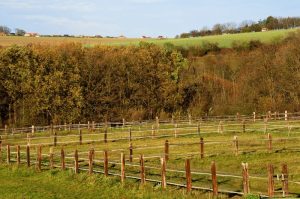
How Much Land Do You Need For Goats?
Goats are the ideal livestock for smaller homesteads, and their size and space requirements give them an advantage over running cattle in a more modest operation. If you consider adding goats to your acreage, you will need to know how many you can raise per acre of land.
How many goats should you have per acre? The number of goats you keep per acre will depend on several variables, but you can expect to sustainably raise 6-8 goats on one acre of land. If you are planning to supplement feed and are not concerned about sustainability, you can raise a much larger number than this.
Want to know how to create the best sustainable methods for raising multiple goats on your land? Keep reading! In this article, I’ll share all I know about keeping goats on your land!
How Many Goats Per Acre: Things to Take Into Account
When I talk about sustainability, I am referring to the ability of the herd to live on pasture alone, with little to no supplemental feed. Keeping your goats entirely on pasture has many benefits, including a varied diet for your animals, the ability to fulfill their natural need to browse and graze, and the opportunity to save money on supplemental feed. Several variables can affect the number of goats you can keep on an acre of land sustainably, so while 6-8 is the average number of goats per acre, this will increase or decrease according to the following factors:
Breed
The breed of goat will affect your numbers for several reasons. Goats vary significantly in size. A Boer (a popular meat breed) can reach up to 300 pounds at maturity, while a Nigerian Dwarf (a popular dairy breed) should not weigh more than 75 pounds fully grown. A goat weighing 300 lbs will eat more than a 75-lb goat. The breed of goat also affects feed efficiency, particularly in meat goats. Some improved breeds are highly efficient at converting feed to meat, requiring a smaller amount of feed to reach their growth potential.
To learn about the most profitable goat breeds, visit my article 10 Most Profitable Goat Breeds and How to Maximize Profit.
Stage of Life
The stage of life of your goats will affect their required feed. For example, a lactating goat will require significantly more feed per pound than a buck or a doe not in milk. For this reason, an active dairy operation may need more space per goat than a meat or brush-clearing operation.
Soil Quality
Soil quality will have a significant impact on the growth potential of the land. Rich, healthy soil will grow lush vegetation, while poor spoil will see limited growth and many weeds. If you have poor soil quality, you can expect a smaller yield than you would accomplish with rich, fertile soil.

Climate
While you can affect soil quality, you cannot have much influence on your climate (outside of supplemental irrigation). Regular rainfall will yield significantly faster re-growth than drier conditions. In arid regions, unless your pasture is outfitted with sprinklers, your land may only be able to support two goats per acre.
When answering how many goats you can sustainably add to your operation, you will need to consider multiple factors. A Florida rancher who raises small Pygmy goats will probably be able to keep quite a few more goats per acre than a Southwest meat operation raising Boer goats.
Rotational Grazing to Support Goats and Pastures
When it comes to raising goats on pasture, there is one thing that almost every expert agrees on: rotational grazing is the gold standard for both the pasture’s health and the herd’s health. Let’s look at why this is.
Rotational grazing keeps the pasture healthy.
This method of pasture management allows the fields time for rest and growth before re-introducing the animals to the area. After you move your goats to the next pasture in the rotation, the previous area will have the opportunity to produce a healthy yield again without interference from the herd. If you do not allow the field to rest, it will be fighting the animals as it attempts to grow, leaving it struggling to replenish its growth.
Rotational grazing keeps the goats healthy.
Parasites are an unavoidable part of farming. It is usual for an animal to have a degree of parasites, but when the load gets too high, it can cause serious illness. It is necessary, therefore, to control parasites as much as possible. How does rotational grazing help with parasitic load?
Parasites are ingested while animals are grazing (one reason it is ideal is to allow goats to browse above grazing level). Once the parasites are ingested, they will reproduce in the digestive tract, and the eggs will leave the body when the animal eliminates. Repeating the process, these eggs will hatch and again be ingested by another animal. Parasitic larvae hatch with a pack of fat attached to their backs – this is meant to sustain them for about six weeks or until they find a new host. If your animals are moving paddocks each week, the larvae are vulnerable and unable to find a new host. They will die off within 4-6 weeks, leaving the pasture with significantly fewer parasites than when the goats left.
How to Rotate a Goat Pasture
How you rotate your pastures will depend on your space. If you have enough land, you should ideally break your pasture into six different sections, giving your herd one week per section before moving them to the next. This will provide your pastures six weeks to rest (and allow most parasites to die off) before grazing again.
These sections can be small pastures, depending on the number of goats you have. Even a ½ acre of field can be divided into multiple paddocks if you only have a few goats. To get all the benefits of rotational grazing, you will want to have at least four sections. Again, these don’t have to be large areas.
If your goats return to a barn or other permanent structure at night, you can keep the barn in the middle of the pastures so each section can access the barn. If the structure’s location makes this possible, it will provide additional convenience.

You Can Have More Goats Per Acre If Supplementing Feed
The advice of an acre of land sustaining an average of 6-8 goats assumes no additional feed will be provided. You can have significantly more goats per acre if you plan to supplement your herd’s feed with hay. As a general reference, the average goat will eat 3-4% of its body weight in hay daily, with lactating goats adding ½-1%.
As an example of this scenario, you may decide that you need to have 30 goats for your meat or dairy goat operation (plus kids, depending on the season), but you only have two acres of pasture. No matter the region in which you live, you will need more pasture to sustain your herd. This doesn’t mean that you cannot move forward with your operation – instead, you will need to bring in hay to feed them twice daily. This is a common practice and one utilized by the majority of more extensive livestock operations. Because goats prefer to browse and not graze, bringing in hay and other forage from your land (or your neighbor’s), including cut tree branches, hedge clippings, and shrubs, is a good idea. This will provide a variety in the diet but also help to prevent boredom and provide enrichment.
Of course, this does not mean you can go ahead and overcrowd your pastures, as that creates an animal welfare concern. Goats need an absolute minimum of 200 square feet of space per animal (though we recommend significantly more than this). If your goats have too little space, this will lead to stress, depression, boredom, and numerous health problems due to parasitic load and sanitation challenges. When considering how many goats to add to your operation, you will need to consider both logistics and the welfare of your animals.
To learn how to keep your goats entertained and enriched, check out my article What Do Goats Like to Play With? Fun Goat Toy Ideas.
How Many Goats You Keep Will Depend On Several Factors
Again, the number of goats you can keep on your property will depend on multiple variables, including the breed of goats you own, the climate of the region in which you live, and the overall health of your pastures. Even if you are planning to bring in supplemental feed, you will still need to consider several factors before deciding on how many goats to add to your operation, including parasitic interventions and enrichment opportunities. Whichever route you choose, good pasture management, like rotational grazing, will keep your acreage (and your herd) both productive and healthy.
If you plan on raising goats, it’s vital that you’re able to recognize emotional changes in your animals. Changes like these can be proof of both physical or mental health problems. To learn more, visit my article How to Tell if a Goat is Depressed (And What to Do About it).
